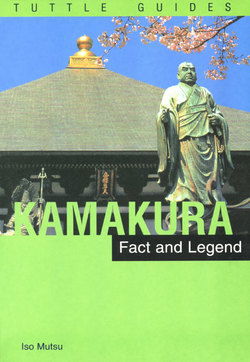Читать книгу Kamakura: Fact & Legend - Iso Mutsu - Страница 21
ОглавлениеKamakura Shrine
THIS IS the only temple in Kamakura of modern foundation. It was constructed as recently as the year 1869 by order of the emperor Meiji, and is of pure Shinto architecture. Prince Morinaga, to whom the shrine is dedicated, was formerly the head priest of a temple on Hiei-zan, near Kyoto, and was also known as Daito-no-miya from the name of his place of residence. A stone bridge spanning a small stream gives access to two courtyards, shaded with a grove of pines, maples, and many cherry trees.
On the right-hand side of the upper court is a building enclosed within a high dark palisade. This sanctum was specially erected as a rest-house for the emperor Meiji when he visited this shrine in 1873. It consists of a wide matted verandah with two rooms—the apartment on the right contains the raised dais upon which His Majesty reposed. The tokonoma is decorated with an interesting work of art in the shape of a life-sized and vigorous equestrian statue of Prince Morinaga, in which the spirit of medieval times is well reflected. The ill-fated prince is clad in picturesque armor, equipped with a case of arrows, and grasping a long bow. This carving was the work of a modern sculptor, Kisai Yamada, and was executed in 1893.
Kamakura Shrine is of historic and tragic interest, for here the unfortunate Prince Morinaga, third son of the emperor Go-Daigo, was imprisoned for seven months in a dark cavern behind the temple and there cruelly assassinated in 1335 at the age of twenty-seven. This gallant prince had been the mainstay of the revolution which had for its object the overthrow of the military government and the restoration of the imperial ascendancy, which had been divested of all power by the military rule at Kamakura. However, the crafty and ambitious Takauji (who became the first Ashikaga shogun), realizing that the prince was a serious obstacle to his design of establishing himself at Kamakura as the military governor and practical ruler of the empire, conspired to poison the emperor's mind against his own son, and falsely concocted a plot to the effect that the innocent Prince Morinaga was scheming to depose his imperial parent and to usurp the throne in his stead. Unhappily, the emperor Go-Daigo was over-susceptible to the influence of his advisers, and, lending a ready ear to these sinister reports, in November 1334 he caused a warrant to be issued for his son's arrest.
In answer to the accusation, Prince Morinaga inscribed a pathetic appeal to the parent whose cause he had so loyally served, and passionately asserted his innocence. He concludes with the following words:
"In spite of all this I have unwittingly offended. I would appeal to heaven, but the sun and moon have no favor for an unfilial son. I would bow my head and cry to the earth for help, but the mountains and rivers do not harbor a disloyal subject. The tie between father and son is severed and I am cast away. I have no longer anything to hope for in this world. If I may be pardoned, stripped of my rank, and permitted to enter religion, there will be no cause for regret. In my deep sorrow I cannot say more."
